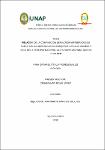| dc.contributor.advisor | Sánchez Vela, Carol Margareth | |
| dc.contributor.author | Rojas López, César Mario | |
| dc.date.accessioned | 2021-10-07T12:42:48Z | |
| dc.date.available | 2021-10-07T12:42:48Z | |
| dc.date.issued | 2019 | |
| dc.identifier.uri | https://hdl.handle.net/20.500.12737/7506 | |
| dc.description.abstract | Se realizó un estudio en la Reserva Allpahuayo Mishana; ubicado al suroeste de Iquitos en la Amazonia Peruana, entre el rio nanay en el noroeste y la carretera Iquitos – Nauta, cuyo objetivo fue identificar y clasificar los macroinvertebrados del suelo en los varillales seco y húmedo y la relación que tiene estos con la necromasa, cuantificar los macroinvertebrados encontradas en la zona de estudio, en la que se trabajó en una área de 25cm x 25cm, el cual se aplicó la metodología del Programa Internacional Tropical Soil Biology and Fertility (TSBF), para esta investigación los materiales que más se usaron fue el alcohol, las botellas de plástico y vidrio, los rotuladores y las muestras colectadas en el campo, lo cual dichas muestras fueron identificadas en laboratorio según las clasificación de Mc Gavin, (2002), obteniendo como resultado Para los dos tipos de varillal seco y húmedo, se reportó un total de 3 filos, 6 clases y 15 órdenes, siendo Arthropoda el filo que presento el mayor número de ordenes (9) encontrándose en insecta la mayor cantidad de órdenes.
Al comparar el número de órdenes por tipos de varillal seco y húmedo, en los terrenos administrados por IIAP y el INIA, Se determinó que existe una diferencia Significativa, con 14 clases en ambos varillales en los terrenos de IIAP y 10 y 9 clases en varillales seco y húmedo respectivamente en los terrenos del INIA. Para los diferentes tipos de varillales se reporta una densidad de macroinvertebrados mayor en los órdenes: Isoptera, Hymenoptera, collembola y orthoptera. Al comparar la densidad por tipos de varillal seco y húmedo existe una diferencia significativa. En el varillal seco con 1596 ind, y en varillal húmedo en 1173 en los terrenos administrados por el IIAP. Los varillales secos y húmedos que se encuentran ubicados en los terrenos administrados por el IIAP tienen mayor nivel de necromasa, en esta zona la actividad antrópica es mínima, mientras que en los varillaes seco y húmedo en las zonas administradas por el INIA la necromasa es poca, debido que en esta zona las actividades antrópicas están a la vanguardia. Destruyendo en su totalidad esta parte de la reserva. | es_PE |
| dc.description.abstract | A study was carried out in the Allpahuayo Mishana Reserve; located southwest of Iquitos in the Peruvian Amazon, between the nanay river in the northwest and the Iquitos - Nauta highway, whose objective was to identify and classify the macroinvertebrates of the soil in the dry and wet varillales and the relationship these have with necromass, quantify the macroinvertebrates found in the study area, in which we worked in an area of 25cm x 25cm, which was applied the methodology of the International Tropical Soil Biology and Fertility Program (TSBF), for this research the materials that were most used It was alcohol, plastic and glass bottles, markers and samples collected in the field, which said samples were identified in the laboratory according to the classification of Mc Gavin, (2002), obtaining as a result For the two types of dry rod and wet, a total of 3 phyla, 6 classes and 15 orders were reported, Arthropoda being the phylum that presented the highest number of orders (9) being found in insecta the largest c number of orders.
When comparing the number of orders by types of dry and wet varillal, in the lands managed by IIAP and INIA, it was determined that there is a significant difference, with 14 classes in both varillales in the IIAP lands and 10 and 9 classes in varillales dry and wet respectively on the INIA lands. For the different types of varillales, a higher density of macroinvertebrates is reported in the orders: Isoptera, Hymenoptera, collembola and orthoptera. When comparing the density by types of dry and wet rebar there is a significant difference. In dry varillal with 1596 ind, and in wet varillal in 1173 in the lands administered by the IIAP. The dry and wet rods that are located in the lands managed by the IIAP have a higher level of necromass, in this area the anthropic activity is minimal, while in the dry and wet rods in the areas administered by the INIA the necromass is little , because in this area anthropic activities are at the forefront. Destroying this part of the reserve in its entirety. | es_PE |
| dc.format | application/pdf | es_PE |
| dc.language.iso | spa | es_PE |
| dc.publisher | Universidad Nacional de la Amazonía Peruana | es_PE |
| dc.rights | info:eu-repo/semantics/openAccess | es_PE |
| dc.rights.uri | https://creativecommons.org/licenses/by/4.0/ | es_PE |
| dc.subject | Microbiología del suelo | es_PE |
| dc.subject | Bosque tropical húmedo | es_PE |
| dc.subject | Reservas naturales | es_PE |
| dc.title | Relación de la composición de macroinvertebrados de suelo con la necromasa en bosque de varillal húmedo y seco de la Reserva Nacional Allpahuayo Mishana, Iquitos, Perú 2015 | es_PE |
| dc.type | info:eu-repo/semantics/bachelorThesis | es_PE |
| thesis.degree.discipline | Ciencias Biológicas | es_PE |
| thesis.degree.grantor | Universidad Nacional de la Amazonía Peruana. Facultad de Ciencias Biológicas | es_PE |
| thesis.degree.name | Biólogo | es_PE |
| dc.subject.ocde | http://purl.org/pe-repo/ocde/ford#1.06.01 | es_PE |
| renati.author.dni | 42878072 | |
| renati.advisor.orcid | https://orcid.org/0000-0001-7710-4615 | es_PE |
| renati.advisor.dni | 05378922 | |
| renati.type | http://purl.org/pe-repo/renati/type#tesis | es_PE |
| renati.discipline | 511206 | es_PE |
| renati.level | http://purl.org/pe-repo/renati/level#tituloProfesional | es_PE |
| renati.juror | Souza Tecco, Javier | |
| renati.juror | Diaz Jarama, Felicia | |
| renati.juror | Pezo Lozano, Etersit | |
| dc.publisher.country | PE | es_PE |


